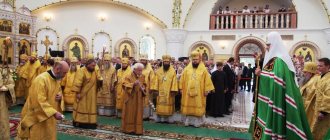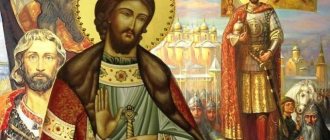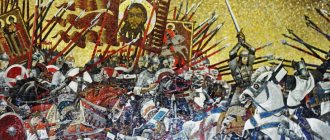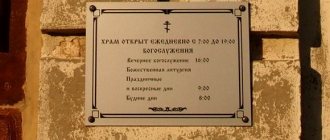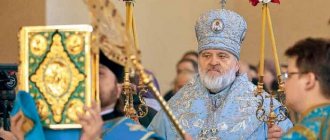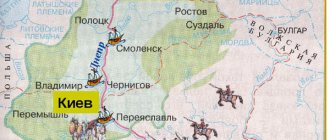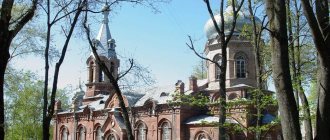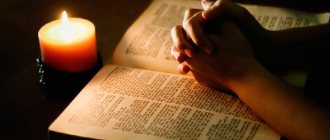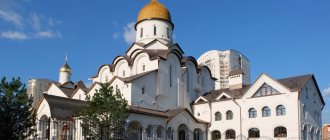Handwritten icon of Igor of Chernigov. The image is made on a linden board with oak dowels, linen felt, chalk gesso, gold leaf, tempera, drying oil, varnish.
Icon painting workshop Radonezh Sergiev Posad.
Against the golden background of the icon, as if in the light of the radiance of Divine glory, the image of the blessed Prince Igor of Chernigov opens to our gaze. The saint is dressed in a blue chiton, over which is thrown a crimson cloak embroidered with a golden pattern. The crimson color symbolizes the royal dignity of Saint Igor. In his right hand he holds a cross, a symbol of the Savior's suffering on the cross. In his left hand, Prince Igor squeezes a sword. In the context of this image, the sword symbolizes the princely power of Saint Igor, a symbol of the fight against evil forces. Symbol of victory over enemies. The head of Saint Igor is crowned with a princely headdress.
Correct, harmonious facial features personify the spiritual beauty of a celestial being. A stern facial expression, without excessive sensuality and emotionality, shows detachment from the world, concentration in serving the Lord. The face is painted with delicate ocher melts. The pinkish tones of the blush and lips contrast with the olive color of the sankir, which gives the face additional volume and expressiveness.
Straight and wide folds of clothing set a certain rhythm and movement of the icon, expressing the complete orderliness of spiritual forces. Their strict geometric structure reveals the elasticity of spiritual energy. All elements of the icon are painted with thin, transparent melts, which give depth, softness, and unearthly airiness to the appearance of Igor Chernigovsky.
The icon of Igor of Chernigov is made in the canonical style, in compliance with the centuries-old traditions of icon painting. When painting the icon, a pure and natural palette of colors was used: minerals, semi-precious stones, ocher, earths manually ground with a chime and mixed with yolk. The rich color palette of natural pigments made it possible to achieve moderate saturation and softness of colors characteristic of the Moscow school of writing.
Life of Saint Igor of Chernigov
According to the chronicle, Prince Igor was a brave man and a great hunter of birds and animals, he was a reader of books and a scholar in church books; He was of average height, lean, with a dark complexion, and wore long hair and a small narrow beard beyond the usual.
Before his death, Vsevolod Olgovich (grandson of the middle Yaroslavich - Svyatoslav) called the people of Kiev to Vyshgorod and declared his younger brother Igor his heir. On August 1, 1146, Vsevolod died. Hostility towards Vsevolod, apparently, served to incite hatred towards his brother Igor and all the Olgovichs.
Igor, according to the will of his late brother, ascended the grand-ducal throne, and the people of Kiev on Ugorsky kissed his cross (sworn allegiance). The new prince promised to replace the tiuns - the rulers of Vsevolod's squad, to coordinate with the Kievans the appointment of new tiuns, and to “keep the Kyivans themselves in truth and love.” But soon, due to Igor’s reluctance to displace the tiuns, discontent began in the city. The people of Kiev secretly offered the throne to the Pereyaslavl prince Izyaslav Mstislavich (grandson of Vladimir Monomakh and great-grandson of the younger Yaroslavich - Vsevolod).
Near Kiev, near Lake Nadova, a battle took place between the troops of Prince Igor and Izyaslav Mstislavich, and the Kyiv troops at the height of the battle went over to Izyaslav’s side. “And the warriors of Igor and Vsevolozh robbed Kiyan and Izyaslav: both villages and cattle, taking a lot of property in houses and monasteries.” For four days Igor Olgovich hid in the swamps near Kyiv before being captured on August 13, 1146; was brought to Kyiv and put in a “cut” (a cold log house, without windows or doors). His reign lasted two weeks. While in the woods, the prince became seriously ill and was close to death. Under these conditions, the prince’s opponents allowed him to be “knocked out” from captivity and, according to his will, tonsured into the schema in the Kiev Feodorovsky Monastery (the tonsure was performed by Bishop Euthymius of Pereyaslavl). But the prince recovered, remaining a monk of the monastery.
In 1147, Prince Izyaslav, with the metropolitan and the thousand, called the people of Kiev to a veche at St. Sophia. The Kiev veche, wanting to take revenge on the Olgovich family in connection with the revealed plans to capture or kill Izyaslav, decided to deal with the monastic prince. The Metropolitan and the clergy, especially the brother of the Grand Duke, Vladimir Mstislavich, tried to stop the senseless bloodshed. The rebels burst into the church during the liturgy, grabbed Igor, who was praying before the icon of the Mother of God (later - the “Igor” icon; celebrated on June 5), and dragged him to death. Vladimir Mstislavich managed to recapture Igor from the angry, completely uncontrollable crowd and bring him to his mother’s yard, but the Kievans broke down the gates, tore Igor out of the hands of the defenders, killed him, and dragged his naked body, tying a rope to his leg, and threw it on the market square. Even the prince’s dead body was beaten and desecrated. The next morning the prince was buried in the monastery of St. Simeon, on the outskirts of Kyiv.
L.V. Cherepnin saw in the reprisal against Igor the struggle of the townspeople against the emerging patrimonial system of inheritance of tables - the people of Kiev did not want to be “like backs” (belonging to the backs - inheritance) of the Olgovichs.
From the point of view of B.A. Rybakov, the murder of Prince Igor, in addition to the general dislike of broad sections of the population of Kyiv for the Olgovichs, was also due to the fact that even in the doll of a schema-monk, he posed a real danger to the new Grand Duke Izyaslav Mstislavich. So, half a century later, Izyaslav Mstislavich’s nephew, Rurik Rostislavich, was tonsured a monk by his son-in-law Roman Mstislavich (Izyaslav’s grandson), but at a turn of fate, he took off his hair and again became a prince. Igor went through all the coronation formalities and even concluded a “row” (agreement) with the people of Kiev; The prince also had his own grand ducal seal, on one side of which St. George, Igor’s patron, was depicted, and on the other, St. Sophia, the patroness of Kyiv.
According to V. Ya. Petrukhin, the people of Kiev preferred one branch of the princely family - the “Volodimer tribe”, the descendants of Vladimir Monomakh and Vsevolod Yaroslavich - to another, the Chernigov Olgovichs. The reason for the people of Kiev to support Izyaslav against Igor was Igor’s violation of “order” with the people of Kiev and his reluctance to displace the old tiuns. After Izyaslav’s reign, the prince and the people of Kiev suspected Igor of conspiring with other Olgovichs in order to return to the princely table. To justify their actions, the people of Kiev turn to a previous precedent - the Kyiv uprising of 1068. They consider themselves champions of legitimate princely power, since they deal with Igor as an enemy of Izyaslav Mstislavich, in contrast to the “evil people” who rebelled in 1068, who, on the contrary, freed and enthroned the enemy of the legitimate prince, which is why “much evil came to the city. Igor was dragged alive to the prince's court and killed there, which imitated the prince's court. The scientist compares the death of Igor Olgovich with the death two centuries earlier of his namesake and ancestor - Igor the Old (Igor Rurikovich), who also broke the “series”.
The prince did not leave any children behind.
Prince Igor was canonized in his native Chernigov and is revered by Orthodoxy as a saint and also a passion-bearer.
Days of memory of Igor Olgovich:
September 19 (October 2) - day of the martyrdom of the Holy Blessed Grand Duke Igor of Chernigov and Kyiv (1147) June 5 (18) - transfer of the relics of the Holy Blessed Grand Duke Igor of Chernigov and Kyiv (1150). Igor's Icon of the Mother of God (1147) September 22 (October 5) - in the Cathedral of Tula Saints (since 1987)[20]. Prince Igor is also revered in Catholicism - he is included in the Catholic calendar as Saint Igor II, Prince of Moscow
Prince Igor: tragic fate, terrible death
The name “Igor Icon” was given to the image of the Mother of God in memory of Prince Igor, one of the many great-grandsons of Yaroslav the Wise. He lived in an era of civil strife, when two groups of princes fought for the Kiev throne: some of them belonged to the descendants of Oleg (Olgovichi), and the other to Mstislav (Mstislavichi).
Civil strife broke out after the death of the Kyiv prince Vsevolod Olgovich. The inhabitants of the city hated him for his pride, and this attitude was transferred to his relatives. According to the will, Vsevolod’s brother Igor, Prince of Chernigov, sat on the Kiev throne. The residents of the city swore allegiance to him on the cross, but after two weeks they broke their oath and called the Mstislavichs. In the battle with Izyaslav Mstislavich, the Kiev army betrayed its rightful prince and was handed over to the enemy.
The defeated Prince Igor had to take refuge in the swamps for several days, but he was captured, taken to Kyiv and thrown into an ice log - a log house without windows or doors, where he became so ill that he was already preparing for death.
The chronicles speak of Igor not only as a brave warrior, but also as a pious Christian: he read a lot of spiritual literature, often talked with holy elders and monks, and on the eve of his brother’s death he even thought about taking monastic vows.
Now, when he himself was on the verge of death, he was taken out of prison and allowed to receive the schema in the Feodorovsky Monastery in Kyiv. But the prince, who took the schema under the name Ignatius, recovered, and he was given permission to remain in the monastery as a monk. He devoted all his time to prayers and atonement for sins.
His cousins, however, did not stop fighting for the reign of Kiev, and then less than a year later, in 1147, the city council, in order to take revenge on them, agreed to reprisal against Prince Igor, who accepted monasticism under the name Ignatius.
Despite the intervention of the metropolitan and the clergy, who tried to prevent the murder of an innocent person, despite the opposition of Prince Izyaslav Mstislavich, who sat on the Kiev throne, and his brother Prince Vladimir (by which they endangered themselves), nothing could stop the enraged crowd. She burst straight into the church while the Divine Liturgy was going on there, and Igor was praying on his knees in front of the icon of the Mother of God.
They not only killed him, but also violated his dead body. So Prince Igor, who was involved in civil strife against his will, fell as an innocent victim. Three years later, Prince Yuri Dolgoruky took over the reign of Kiev. His ally became Prince Igor’s brother, Svyatoslav, who reigned in Chernigov, where he transferred the relics of the martyr with honors.
The icon, before which he constantly prayed on his knees, including at his terrible hour of death, has since been called the “Igor Icon of the Mother of God.” After some time, its veneration as miraculous began, and the icon was transferred to the Assumption Cathedral of the Kiev Pechersk Lavra.
After the revolution, the Igor Icon was taken abroad several times, but, nevertheless, it returned to its homeland each time. In 1941, during the German occupation of the city, the icon disappeared, this time without a trace. However, at one time many lists were made from it. One of the most revered today is located in the Assumption Cathedral in Moscow.
On the day of remembrance of the holy noble prince Igor of Chernigov and Kyiv on June 5/18, solemn services and prayers are held, and an akathist is read before the Igor Icon of the Mother of God.
The meaning of the icon of St. Igor
The meaning of the icon of St. Igor lies in the indestructible strength of spirit, represented in the image of the Grand Duke. He personifies the power of faith, martyrdom, firm determination to defend Christian ideals, even at the cost of his own life. The image of the blessed Prince Igor, the story of his life’s path, inspire us, encourage us to fervent prayer and pious deeds. Truly wonderful is God in His saints! Dear believers, brothers and sisters! Do not doubt the help of Saint Igor! Open your heart to him in sincere prayer and he will hear us, heal spiritual and physical infirmities, and help in the successful arrangement of earthly affairs.
Do not forget that in order for a miracle to happen, we ourselves must take care: regularly, with attention, read the prayer, do deeds of faith and love. And don’t forget to give thanks: to thank all the people sent to us by the grace of God to solve our life’s troubles, who shared our joy and sorrow. To thank the Saint, whose prayerful support our heart yearned for, because how many people pray to him for help, but he heard and helped us too. And most importantly, thank the Lord for His boundless love for mankind. He gave the world His saints and every second helps us, people who hope for His great mercies.
Everything in the world happens according to the wise providence of God. Difficulties and sorrows, success and joys. Through earthly trials the Lord strengthens us. By helping each other, praying to the heavenly saints, we are more firmly united in the One Church of Christ. And we believe that the blessed prince Igor of Chernigov will hear all our prayers and show us the boundless mercy of our Lord Jesus Christ. Thank God for everything!
Description of the Igor Icon
The model for painting the Igor Icon was another holy image, known as the icon of the Mother of God “Tenderness,” painted at the turn of the 14th-15th centuries. The most famous such icon is Our Lady of Vladimir.
The icon depicts the Mother of God with the Baby Jesus in her arms. On some lists, the Baby, clinging to Her cheek, puts his arm around the Mother’s neck. The expression of His face is not childishly serious, and the face of the Mother of God is full of tragedy, because She knows what is destined by the Lord and what Her Son will have to endure. Even on non-believers, the Igor Icon of the Mother of God makes an indelible impression.
Buy an icon of Igor of Chernigov
In the Radonezh icon painting workshop you can buy or order a handwritten icon of Igor of Chernigov. Call us and we will help you choose a plot, a compositional solution for the icon, its optimal size and design, or we will write an icon according to your sample.
Free delivery throughout Russia.
If desired, the icon can be consecrated in the Holy Trinity Sergius Lavra.
Peace and goodness to you, dear brothers and sisters, and may the holy saint of God, Igor of Chernigov, accompany you throughout your entire life’s journey.
Similar icons:
Nikola Svyatosha 13000 ₽
Daniil Moskovsky 24000 ₽
Valery Sevastiysky 13000 ₽
Fedor Ushakov 13000 ₽
How does the Igor Icon of the Mother of God help?
Remembering the tragic history associated with the icon, it is believed that the strongest prayer to it will be when someone finds themselves in a very difficult and difficult life situation and prays for salvation; when someone close to you is threatened by trouble or danger.
The significance of the Igor Icon lies in the fact that people also turn to it with prayer for healing from serious illnesses, for protecting a home from fire and theft, for reconciliation with relatives after violent quarrels.
We recommend reading: Chernigov Icon of the Mother of God
